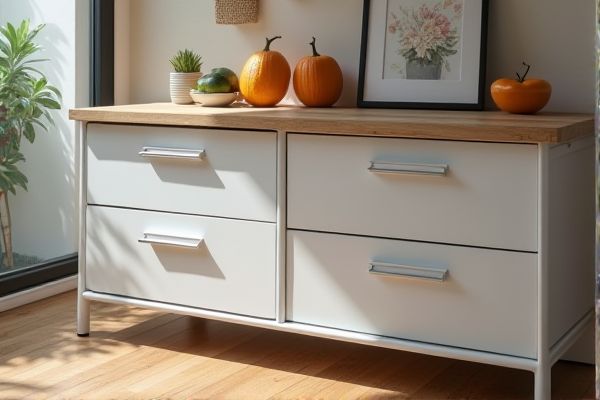
Bin systems provide modular storage with easy visibility and access, ideal for organizing small parts or tools, while drawer systems offer enclosed compartments that protect contents from dust and provide a tidier appearance. Explore the rest of the article to discover which system best suits your storage needs and workspace efficiency.
Table of Comparison
| Feature | Bin System | Drawer System |
|---|---|---|
| Storage Type | Open bins for bulk or small items | Enclosed drawers for organized storage |
| Accessibility | Quick, visible access to contents | Secure, dust-free access |
| Space Efficiency | Flexible stacking, moderate space saving | Maximizes vertical storage, high space efficiency |
| Organization | Best for sorting small parts or hardware | Ideal for detailed categorization and protection |
| Durability | Typically plastic, less protective | Usually metal or reinforced materials |
| Use Cases | Factories, warehouses, retail inventory | Workshops, offices, labs requiring secure storage |
| Cost | Generally lower initial cost | Higher investment, longer term value |
Introduction to Bin and Drawer Systems
Bin systems offer organized storage through open compartments ideal for small parts visibility and quick access, enhancing inventory management efficiency. Drawer systems provide enclosed storage with multiple sliding compartments, protecting items from dust and improving space utilization in workspaces. Your choice between bin and drawer systems depends on accessibility needs, item protection, and storage organization preferences.
What is a Bin System?
A bin system consists of separate containers or compartments designed to organize small parts, tools, or materials efficiently, enhancing accessibility and inventory management. Unlike a drawer system, which uses enclosed sliding trays, bin systems allow quick visual identification and retrieval of items, making them ideal for workshops, warehouses, and retail environments. Your choice depends on the need for visibility, space optimization, and ease of sorting.
What is a Drawer System?
A drawer system is a modular storage solution designed to organize items within compartments that slide in and out smoothly, maximizing space efficiency in closets, cabinets, or workspaces. Unlike bin systems that rely on open or stackable containers, drawer systems provide easy access and protect contents from dust and damage. Your choice of a drawer system can enhance organization and streamline retrieval of tools, clothes, or office supplies.
Key Differences Between Bin and Drawer Systems
Bin systems offer open compartments ideal for quick access and visual inventory management, while drawer systems provide enclosed storage that protects items from dust and allows for organized separation. Drawer systems often maximize space vertically and are suited for smaller, delicate parts, whereas bin systems are preferred for bulk items requiring frequent retrieval. Your choice depends on the balance between accessibility and protection needed for your storage environment.
Pros and Cons of Bin Systems
Bin systems offer efficient organization for small parts, providing clear visibility and easy access to inventory, which reduces retrieval time and helps maintain stock levels. However, they can become cluttered if not regularly maintained, and limited bin size may restrict storage of larger or irregularly shaped items. While ideal for high-turnover, small components, bin systems may lack the flexibility and security that drawer systems provide.
Pros and Cons of Drawer Systems
Drawer systems offer organized, easy access to stored items, making them ideal for environments where quick retrieval is essential. They maximize space efficiency by allowing stacking and compartmentalization but may have drawbacks like limited visibility compared to bin systems and potential difficulty handling larger or irregularly shaped items. Your choice depends on the specific storage needs, weighing the seamless access of drawers against the versatility and visibility of bins.
Applications: When to Use Bin Systems
Bin systems excel in environments requiring rapid access to small parts and components, such as warehouses, manufacturing floors, and retail stockrooms. Your choice to use a bin system is optimal when managing bulk items that need efficient sorting, quick identification, and easy restocking in high-traffic areas. Unlike drawer systems, bin systems offer greater visibility and flexibility for organizing frequently handled inventory.
Applications: When to Use Drawer Systems
Drawer systems are ideal for organizing small parts, tools, and supplies in workshops, laboratories, and medical facilities where easy access and categorization are essential. They provide secure, dust-free storage and improve inventory management by preventing items from being misplaced or damaged. Drawer systems are preferable when frequent retrieval and systematic arrangement of varied items are required for efficiency and workflow optimization.
Cost Comparison: Bin vs. Drawer Systems
Bin systems generally offer a more cost-effective storage solution compared to drawer systems due to lower material and manufacturing expenses. Drawer systems tend to have higher upfront costs driven by complex construction, hardware requirements, and customization options. Businesses prioritizing budget-friendly storage often favor bin systems for their affordability and flexibility in organizing various items.
Choosing the Right Storage Solution for Your Needs
Selecting between a bin system and a drawer system depends on the organization needs and space constraints of your environment. Bin systems offer versatile, stackable storage ideal for small parts and easy visibility, while drawer systems provide secure, dust-free compartments perfect for tools and delicate items. Consider the frequency of access and item size to ensure your storage solution maximizes efficiency and accessibility.
 homyna.com
homyna.com